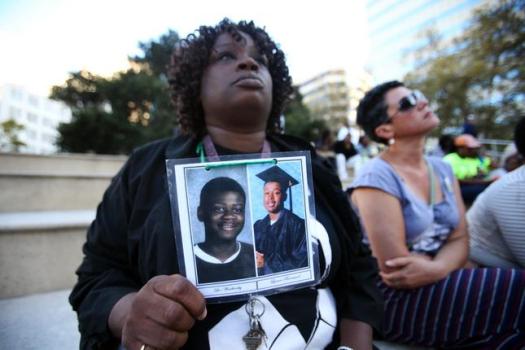|
| http://www.eastbaytimes.com/2017/04/21/oakland-department-proposed-to-try-to-reduce-violence/
Can a new Oakland department reduce violence?

Dinyal New, holds photos of her two sons Lee Weathersby III, 13, and Lamar Broussard, 19, during a vigil for homicide victims of last year and this year at Frank Ogawa Plaza in Oakland, Calif., on Thursday, Sept. 25, 2014. Broussard was killed three weeks after his younger brother Weathersby was gunned down on New Year’s eve of 2014. The vigil was organized by Khadafy Foundation for Non-Violence, a grief support group for parents who have lost a child due to violence. (Ray Chavez/Bay Area News Group)
By Mark Hedin | mhedin@bayareanewsgroup.com | Bay Area News Group
PUBLISHED: April 21, 2017 at 6:28 am | UPDATED: April 21, 2017 at 12:48 pm
OAKLAND — Despite years of voter support for anti-violence programs and increased police staffing, Oakland continues to have the highest per capita homicide rate of major California cities.
Now two council members want to address Oakland’s high crime rate by creating a Department of Violence Prevention, elevating the city’s anti-violence work to department level.
The proposal by City Council President Larry Reid and West Oakland City Council member Lynette Gibson McElhaney describes an “80/80/3” mandate to reduce homicides by 80 percent and produce at least an 80 percent clearance rate for homicides within three years.
Funding for the proposed department, though not its director, is already in place, thanks to 2014’s Measure Z, a 10-year parcel and parking tax expected to generate an estimated $277 million.
Of that, $2 million is allocated annually for fire services. Sixty percent of the rest is designated for police staffing and services, the remaining 40 percent to violence prevention and intervention programs.
Those prevention and intervention programs are run by Oakland Unite, under the Department of Human Services. The program tries to support people at highest risk of committing violence, such as those on probation or parole, or involved in gang/group activity.
The program uses street outreach, life coaching, education, job training and interventions.
“Poll after poll after poll has said that public safety remains the overwhelming priority for the vast majority of Oakland residents. Council President Reid and I believe the voters deserve better,” McElhaney said at a council Life Enrichment Committee hearing April 11.
McElhaney and Reid seek to create a new position overseeing the new department, which would cost the city about $250,000 annually, McElhaney’s office said.
“We don’t want to defund any of the programs from Measure Z” to pay for the position, McElhaney said. The hope is also that elevating violence prevention to a department level will attract additional revenue. She cited Oakland natives Fred Blackwell, of the San Francisco Foundation, and James Head, of the East Bay Community Foundation, as possible supporters.
“The Oakland Police Department currently lacks the capacity to investigate domestic violence or aggravated assaults at the level that they are occurring, and so we know that we must do more,” she said.
“If you just look at the clearance rates, we have so many homicides that are tumbling in on top of each other we’re not getting to resolutions,” McElhaney said.
McElhaney said a reduction in homicides would save the city millions in police overtime that currently goes into investigating the killings.
Beyond that, the average cost of a homicide is $1.5 million in criminal justice costs, lost wages and the higher costs of doing business in a dangerous environment, such as for insurance, McElhaney said.
The time dedicated to homicide investigations also draws police away from their other duties, she pointed out.
“While this unrelenting homicide epidemic continues to rage in Oakland, we have also seen skyrocketing property crime, up 24 percent since 2008, a 31 percent increase in burglaries in 2017 as opposed to 2016,” she said.
She said creating a new department will free the Department of Human Services to concentrate on its other responsibilities, such as homelessness, and give violence prevention the attention it requires and that voters have repeatedly said they want.
“Currently, Measure Z investments are led by the chief of fire and the chief of police, who both report directly to the city administrator. Our intervention and prevention strategies are held by a program manager way down into our organizational chart,” McElhaney said in an interview.
McElhaney specified five focal points for the proposed new department: homicide reduction, domestic violence prevention, anti-child trafficking measures, improved prosecutions and victim assistance.
The framework is modeled on Richmond’s Office of Neighborhood Safety which has produced a 70 percent reduction in homicides since its launch in 2007.
Similar programs brought a 41 percent reduction in violence in Stockton and a 25 percent drop in San Francisco, McElhaney said.
While Oakland’s violent crime rate has increased over the past decade, that of the state, nation and Bay Area all have decreased. Oakland’s homicide rate, 20 to 22 homicides per 100,000 people annually, is four to five times greater than the rest of California.
From 2008 to 2016, the violent crime rate in Oakland increased 3.4 percent. It decreased 7.6 percent in California and the Bay Area overall during that time, McElhaney aide Alex Marqusee told the committee, citing FBI data.
Since 2014, 375 Oakland residents, 27 of them children, have been killed in the city, McElhaney said. Her own grandson, Torian Hughes, was slain in a robbery on Mandela Parkway in 2015.
“I was a tough chick from a tough town, had a tough upbringing, but in that identity I found that I had become somewhat numb and removed, having suffered multiple losses in my family from the harsh reality that we are dealing with an epidemic,” she said.
The Life Enrichment Committee endorsed the proposal, with council member Rebecca Kaplan signing on as a co-sponsor. It goes before the council May 16. |
|

